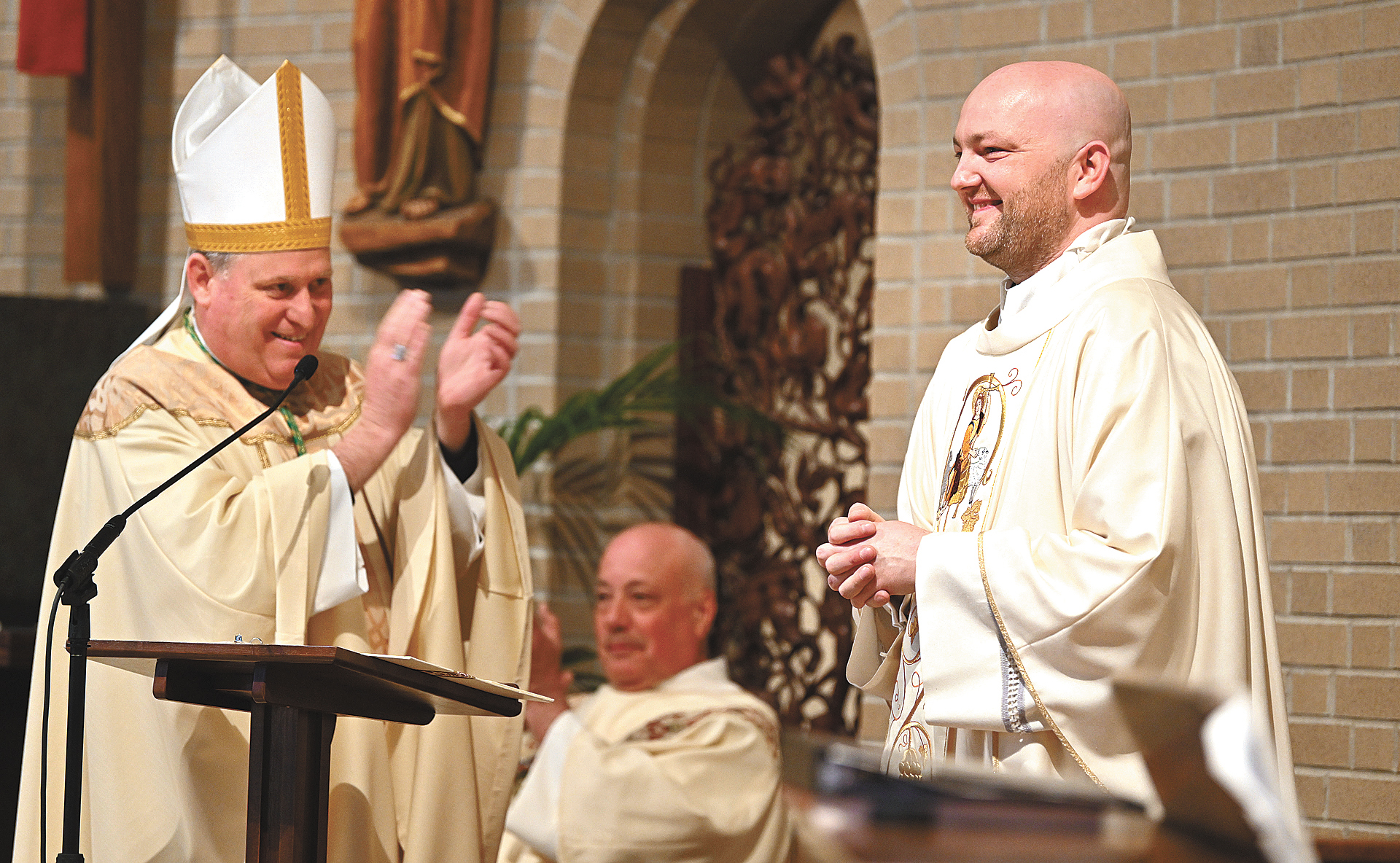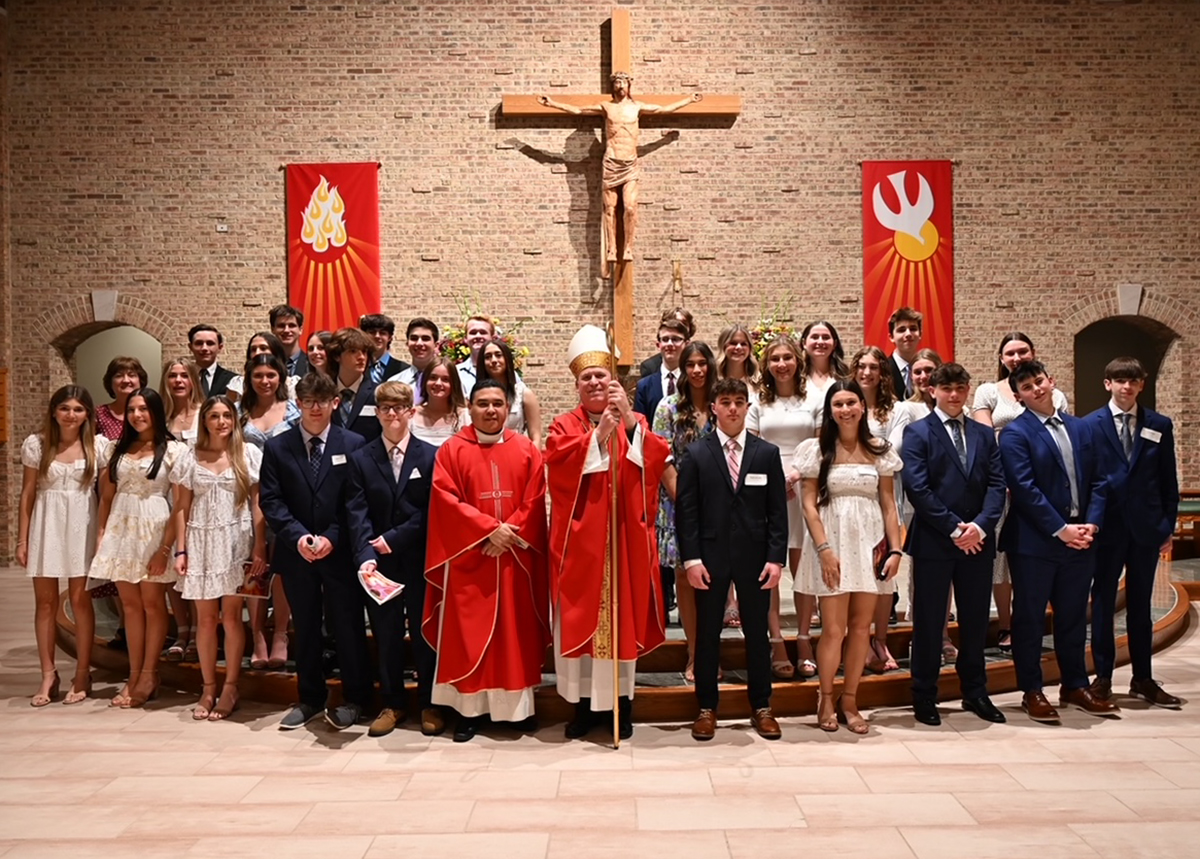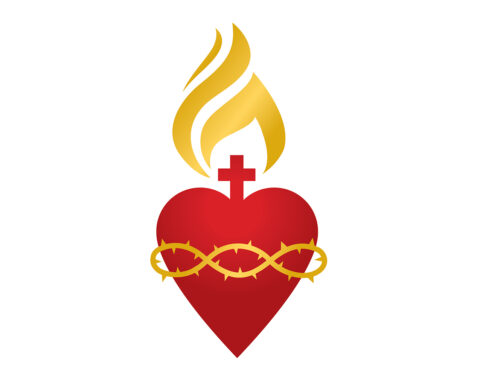It will not be long until our country celebrates a national Eucharistic Congress in Indianapolis as a significant moment in our National Eucharistic Revival. At the heart of our faith is the Eucharist. As we draw closer to Pentecost, we are conscious that the outpouring of the Holy Spirit consecrates us as witnesses to Christ and that the Blessed Eucharist strengthens us for holiness of life.
God’s holy people need the Eucharist to focus our daily living on the things of heaven. The USCCB website references one of the Church’s most impactful theologians to stress our relationship with the Lord in the Eucharist, “St. Thomas Aquinas wrote, ‘It is the law of friendship that friends should live together. … Christ has not left us without his bodily presence in this our pilgrimage, but he joins us to himself in this sacrament in the reality of his body and blood’” (Summa Theologiae, III q. 75, a. 1). Another name for “friends” of the Lord Jesus is “saints.”
How often do we realize that sainthood is our goal? Likely, official canonization is not in our future. However, by living a holy life, we hope to find ourselves among the heavenly Communion of Saints. Our Diocese of Paterson is blessed to have two examples, very close by, who are — in fact – on their way to canonization, please God, so that they may inspire the Church throughout the world. In the meantime, they are our special “local” friends in heaven who lend us inspiration to keep the faith. Blessed Miriam Teresa Demjanovich and Brother Marinus are two religious, one a Sister of Charity of Saint Elizabeth and one a Benedictine Monk of Saint Paul’s Abbey. Blessed Miriam Teresa and Brother Marinus show us that extraordinary holiness is not beyond our reach. The Eucharist makes the one sacrifice of Christ accessible to us and so all things are possible through our union in the Eucharist with his one sacrifice.
In the time that I have served as Bishop, I have been very grateful to learn so much about the wonderful history of our Diocese. We can look at our “history” from many different perspectives. I was particularly blessed to be “introduced” to the history of our Diocese during May and June of 2020, in the time leading up to my ordination and installation as Bishop. During that time, I was able to read Living Stones, the wonderful book written by Msgr. Raymond Kupke on the occasion of the 50th Anniversary of our Diocese in 1987.
In recent months, many of us have been happy to “return” to Living Stones by means of the podcast Coffee with Kupke. On the podcast, Father Paul Manning, Diocesan Vicar for Evangelization, and Msgr. Kupke have been on a journey through the history recounted in Living Stones, going back to the beginnings of the presence of the Catholic Faith in Northern New Jersey, leading up to the foundation of the Diocese of Paterson in 1937. I believe their journey will continue in coming episodes, hopefully leading even to our more “recent history,” post-1987. I will be checking with them about that.
In recent days, I have been reminded of some very significant moments in our “recent history” related to Blessed Miriam Teresa Demjanovich and Brother Marinus. On May 8th, we will celebrate the Feast Day of Blessed Miriam Teresa Demjanovich and the cause for the beatification of Brother Marinus continues to advance through our prayerful efforts. In preparation for the Feast Day of Blessed Miriam Teresa, I returned to some sources to refresh my memory with regard to her exemplary life and some of the significant moments in the “cause” for her canonization. In a 1926 letter, Sister Miriam Teresa wrote, “And even in the world I felt very intensely that if people only sought God in all earnestness they would find Him. And if all would only make use of the ordinary duties and trials of their state in the way God intended, they would all become saints.” The various stages of the process of canonization are a journey much like our own pilgrimage toward heaven that has many stops along the way.
I would hope that most readers are familiar with “Blessed Miriam.” For those who may not be familiar with her story or for those (like me) who could benefit from a brief “refreshment of memory,” there is a great deal of information and an EXCELLENT nine-minute video of Blessed Miriam’s biography on the website of the Sisters of Charity of St. Elizabeth.
I also found the biographical summary and other information about Blessed Miriam that is available on Wikipedia to be very helpful. In particular, I was struck by the following paragraph that describes some of the “moments” in the process of her cause for canonization:
On Thursday, May 10, 2012, Demjanovich was proclaimed venerable by Pope Benedict XVI. On December 17, 2013, Pope Francis approved the attribution of miraculous healing to the intercession of Demjanovich, opening the way to her beatification. The cause of her beatification involved the restoration of perfect vision to a boy who had been diagnosed as legally blind because of macular degeneration. Msgr. Giampaolo Rizzotti of the Congregation for the Causes of the Saints added that the miracle took place in 1964. Demjanovich was beatified at a ceremony on October 4, 2014, held at the Cathedral Basilica of the Sacred Heart in Newark. This was the first time a beatification had ever been held in the United States. In 2017, Stanley Rother and Solanus Casey would become the second and third Americans to be beatified in the United States.
The following day, Kurt Burnette, Bishop of the Byzantine Catholic Eparchy of Passaic to which Demjanovich belonged, presided at a Divine Liturgy at the parish of her baptism, Saint John the Baptist Church in Bayonne.
The Wikipedia article also says the following, under the heading of “Religious Life and Death”:
Demjanovich’s profession of permanent religious vows was made in periculo mortis (danger of death) on 2 April 1927. She was operated on for appendicitis on 6 May and died on 8 May 1927. Her funeral was held 11 May 1927 at Holy Family Chapel in Convent Station, New Jersey, and she was buried at Holy Family Cemetery on the grounds of her order’s motherhouse.
Favors and cures attributed to her intercession are continually being reported.
If you watch the nine-minute video on the Sisters of Charity website, you will learn and see how Blessed Miriam’s remains were exhumed as part of the cause for canonization, were moved from a vestibule outside Holy Family Chapel, and then later moved to the “chapel proper.” Holy Family Chapel is located on the grounds of the Motherhouse of the Sisters of Charity in Convent Station — also the home of the Academy of St. Elizabeth High School and St. Elizabeth University.
If you have never visited the Holy Family Chapel or the shrine to Blessed Miriam Teresa, I would highly recommend a visit. I would also recommend a visit for anyone who may be praying for a “special intention.” When we read a line (in a Wikipedia article or another source) that says, “Favors and cures attributed to her intercession are continually being reported,” we may or may not give it much consideration, but we should always remember that “miracles happen” and very often miracles come with the help of an “intercessor.”
The intercession of our Blessed Mother, the Saints, and those “on the way” to canonization has a long and rich history in our Church and our experience as people of Faith. The upcoming Feast of Blessed Miriam Teresa Demjanovich is an opportunity for us to be reminded, not only of the rich, spiritual history of the Church here in our own diocese, but, also to be reminded that we have “friends” and intercessors in Heaven, whose help and favor we can seek, day by day.
As we think about Blessed Miriam Teresa and the rich, spiritual history of our diocese, we also recall that we have another active “cause for canonization” here in our diocese. I hope that readers of this column are also aware of the heroic life and witness of “Brother Marinus,” Captain Leonard LaRue. Brother Marinus is another person of holiness who lived for many years here in our diocese at St. Paul’s Abbey in Newton. An article in the National Catholic Register begins to tell the story in this way:
For the longest time, Benedictine monks at St. Paul Benedictine Abbey in Newton, New Jersey, did not know modest Brother Marinus LaRue, their dishwasher, bell ringer and gift-shop worker, had been a U.S. Merchant Marine captain. During the Korean War, Leonard LaRue headed what became — and remains — the largest humanitarian rescue operation by a single vessel in history, whether during war or civilian conditions. In a single trip, he evacuated 14,000 refugees to safety in a freighter designed to carry 47 officers and only 12 passengers, along with the cargo.
When fellow monks eventually discovered he was responsible for what was called “The Christmas Miracle,” Brother Marinus humbly preferred not to talk about the details. Now, many will learn of the unmatched effort he directed, as his canonization cause has been advanced.
At the U.S. Conference of Catholic Bishops’ June 16-18 assembly, 99% of the bishops voted to advance the canonization cause of Servant of God Brother Marinus. Bishop Arthur Serratelli of Paterson, New Jersey, opened his cause in 2019.
You can find more information on Capt. LaRue/Brother Marinus and on the (early) steps in his cause for canonization by going to the website of the “Apostleship for the Sea.”
The Dogmatic Constitution on the Church, Lumen Gentium, describes one of the gifts that consecrated religious give to the Church, “The people of God have no lasting city here below, but look forward to one that is to come. Since this is so, the religious state, whose purpose is to free its members from earthly cares, more fully manifests to all believers the presence of heavenly goods already possessed here below” (LG, 44). In the Eucharist, we pray that we “may become one body, one spirit in Christ” (Eucharistic Prayer III). Our heavenly friends show us what is possible when we unite our efforts as members of the Body of Christ, the Church, to give glory to God through our lives.
In this month of May, which begins with the Feast of St. Joseph, the Worker and is dedicated to Mary, our Blessed Mother, let us continue to call on the intercession of Mary and the Saints in our daily prayers. Let us give thanks for the rich spiritual history of our Diocese and for the women and men who continue to inspire us by their lives of Faith and holiness.
Blessed Miriam Teresa, Br. Marinus, and all holy men and women, pray for us.






